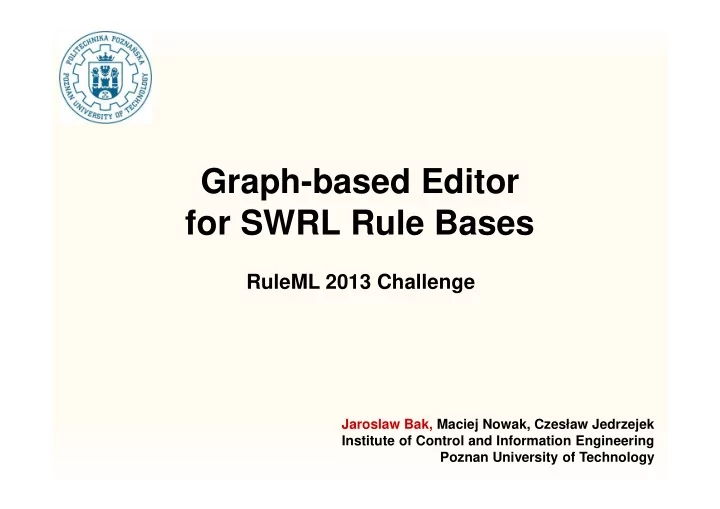

Graph-based Editor for SWRL Rule Bases RuleML 2013 Challenge Jaroslaw Bak, Maciej Nowak, Czesław Jedrzejek Institute of Control and Information Engineering Poznan University of Technology
Outline 1. Motivation 2. Graph-based Editor 3. Demo time! 4. Conclusions and Future Work 2 http://draco.kari.put.poznan.pl/ruleml2013_SWRLEditor
Motivation • Ontologies and rules are too complex to handle by an ordinary user • Rules written in declarative code are hard to read/write • Decision tables and trees have different representation of facts and rules • Graphs are easy-to-understand by an untrained user • Integration of an ontology, rules and data in one graph- based form is convenient and understandable • We want to provide an easy-to-use and easy-to- understand tool, where ontologies, rules and graphs can support user’s work 3
Graph-based Editor (1) • Represents ontology, rules and data as directed graphs • Supports OWL and SWRL (Semantic Web Rule Language) • Performs reasoning by the Pellet engine • Presents results of the reasoning process on a graph 4
Graph-based Editor (2) • Each graph consists of nodes (classes/objects/values) and edges (relations) • Each type of node is represented in different colour and shape • Two kinds of ontology visualization: trees (taxonomies of classes and properties) and graphs • Rules can be created visually and executed • Reasoning process modifies all graphs and trees (if applicable) • Graph structure can be manipulated by using specialized layouts or by manual rearrangement 5
Graph-based Editor (3) Element Graph-based representation OWL Class OWL Class instance Object property between two OWL instances Datatype property between an object and a value 6
Demo Time! 7
Family Relationships Ontology • We modified an ontology developed by Christine Golbreich The ontology contains the usual classes ( Person, • Man, Woman etc.) and relationships within a family ( hasConsort, hasChild, hasParent , etc.) • Moreover, it contains also a number of SWRL rules • We added some classes, relations and rules • We introduced a set of instances 8
Family Relationships Ontology - Instances 9
Family Relationships Ontology - Rules Person(?x), Person(?y), Person(?w), Person(?z), hasParent(?w,?z), hasParent(?x,?y), hasSibling(?y,?z) → hasCousin (?x,?w) Person(?x), Person(?y), Person(?w), hasGrandparent(?x,?y), hasFather(?y,?w) → hasGreatGrandfather (?x,?w), GreatGrandfather(?w) 10
Conclusions and Future Work • Our tool integrates ontology, rules, and data in a graph-based representation and supports reasoning by the Pellet engine • All elements are represented on a directed graph • Creation of SWRL rules is simpler than usual • Graph-based representation is very intuitive, easy-to- understand and easy-to-use • We will extend our tool to support: � Queries execution with graphical answers, � Database interface, � OWL 2 RL and QL Profiles � Ontology creation and modification 11
THE END Thank you for your attention! 12
Demo presentation and download at http://draco.kari.put.poznan.pl/ruleml2013_SWRLEditor 13
Recommend
More recommend